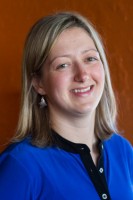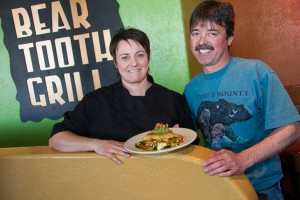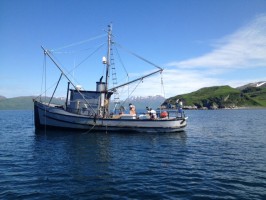Two UAA M.B.A. students bring Kodiak seafood to local consumer market
by Kathleen McCoy |
Wild Alaska salmon has long been the leviathan when it comes to grabbing attention as our state's tasty finfish. But in our cold northern waters, others also thrive, and two M.B.A. students at UAA are guiding them to market.
The students are Kelly Harrell, 32, and Peter Arlein, 28, both full-time professionals navigating graduate school courses on nights and weekends at UAA. Each is about two-thirds of the way through their program. In April, they launched Kodiak Jig Seafoods, a social enterprise linking Kodiak's Pacific cod and rockfish catchers with Anchorage consumers, fish markets and restaurateurs.
Harrell is the executive director of Alaska Marine Conservation Council, a nonprofit that since 1994 has advocated for healthy fish and healthy coastal communities able to sustain their fishermen.
Arlein works for a public relations firm supporting the Alaska Seafood Marketing Institute. The two met in class at UAA, and when Harrell was ready to promote the jig-caught seafood, she tapped Arlein to help with promotion.
AMCC's endeavor is in collaboration with the Alaska Jig Association, local fishermen who harvest from small boats with hook and line. Formed in 2004, it advocates for entry-level opportunities in Alaska fisheries, and is part of a nationwide network of community-based fishing organizations.
Financial support to launch the jig-caught marketing campaign came from a $90,000 National Fish and Wildlife Foundation grant in 2012. AMCC used part of the money to host seminars for fishermen on how to take better care of the fish they caught so they could deliver higher quality and command a better price. Harrell says the goal is to get fishermen 40-100 percent more for their catch through the program
Kelly Harrell, UAA M.B.A. student and executive director for the Alaska Marine Conservation Council. Photo courtesy AMCC.
Entry barriers into the fishery are low, Harrell said. Licenses to jig cost $75. "Essentially, if you have a boat, some bait and some hooks, you can go catch fish," she said.

Peter Arlein, UAA M.B.A. student, met Harrell in class. When she was ready to market Kodiak Jig Seafoods, she tapped him for marketing help. Photo courtesy AMCC.
The jig-caught seafood campaign is a second chapter in AMCC's Catch of the Season program with the same goal of linking locally caught seafood with Alaska consumers. Past efforts included three cycles of bringing short-season the larger, meatier bairdi (tanner) crab to consumers through customer pre-orders in Kodiak, Anchorage and even Homer.
In a 2012 article Harrell wrote for the National Fisherman, she celebrated the success of the Tanner crab campaign, noting that Holland America/Princess purchased 8,000 pounds that year for their five Alaska lodges.
That connection proved significant. Philippe Janicka works as beverage operations manager at Holland America/Princess. When AMCC offered some rockfish and Pacific cod for him to try this year, he brought it home to his wife to prepare. She just happens to be Natalie Janicka, executive chef for Bear Tooth Grill. The chef whipped some up for their dinner, and declared she was sold.
"It's so plump and buttery," Natalie Janicka said. "Thicker in the center of the filet, with a nice big flake."
The difference, she says, comes from the way fish are handled when harvested.
She followed up with her bosses, and by late April, Bear Tooth was offering a Kodiak black rockfish special through Kodiak Jig Seafoods. They plan roll the jig-caught Pacific cod into their menu year-round. Janicka said they'll prepare it broiled, blackened and fried, in fish & chips, and in a summer seviche dish.
Holland America/Princess, The Natural Pantry and Alyeska's Seven Glaciers all signed on to feature either the jig-caught rockfish or Pacific cod.
Landing in Alaska to advocate for community-based fisheries was a natural for Harrell. She grew up fishing, crabbing and boating in coastal Virginia. Part of her family comes from a small fishing community on the Outer Banks of North Carolina, so she grew up understanding coastal communities and the value of local fishing opportunities.

Natalie Janicka, executive chef for the Bear Tooth Grill, and Kodiak jig fisherman Darius Kasprzak. Photo courtesy of AMCC.
That background led her to graduate school in fisheries biology at the University of British Columbia, where a summer internship with the AMCC caught her eye. In 2005, she worked for the nonprofit in Bristol Bay, and knew immediately that Alaska could satisfy her passion and values for supporting local fisheries. She's been with AMMC since, eventually becoming its executive director.
But after about a year in that position, she began thinking an M.B.A. could help further develop a market-based approach to sustainable fisheries. "The course offerings nailed it for me," Harrell said. "The classes in entrepreneurship and small business plan development were exactly what I needed."Arlein's journey to Alaska was more adventure-based. He came out of Colby College with a degree in neuroscience, bound for medical school. But ski and sailing adventures in Colorado, California, Mexico and eventually Alaska, gradually drew him north. He worked a summer as a deckhand aboard a salmon seiner out of Kodiak before starting his M.B.A. His emphasis is business intelligence and data analysis "to satisfy the scientist in me," he said.
Both said the choice of an M.B.A. from UAA, with a $15,000 price tag, was very practical. "It's a great deal," Harrell said, "and the offerings are topnotch."
SIDEBAR: Two UAA teams win in Alaska Business Plan Competition 2014
Taking first place honors in the April 27, 2014 competition were UAA stusents Danny Reeves and Conor Steadman, for their Roving Blue inspiration, a water filtration system that uses ozone gas as a disinfectant. They took first place honors.
Coming in third was the UAA team of UAA student Amy Parrent and Don Harman, president of Ted's Box, creators of containers to ship perishable products. Watch for stories on these innovations this summer.
NOTE: A version of this story by Kathleen McCoy appeared in the Anchorage Daily News on May 11, 2014.
 "Two UAA M.B.A. students bring Kodiak seafood to local consumer market" is licensed under a Creative Commons Attribution-NonCommercial 4.0 International License.
"Two UAA M.B.A. students bring Kodiak seafood to local consumer market" is licensed under a Creative Commons Attribution-NonCommercial 4.0 International License.















